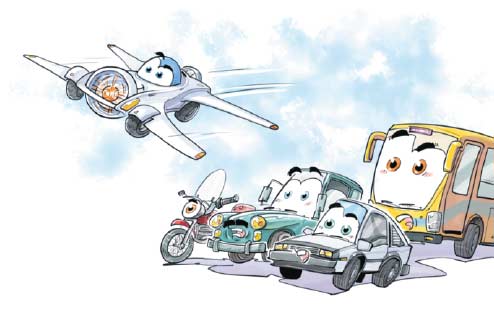Flying car is a good idea but hard to realize
 |
Not likely to be a hit with consumers
 |
| Lin Haiying, a senior researcher in automobiles at Beihang University |
The idea of a flying car seems creative. Combining the advantages of planes and cars, a flying car requires much smaller parking space than a plane and is more convenient than a car, especially when it comes to maneuvering traffic jams.
In general, two types of flying cars have been developed. The first is a fixed-wing flying car, with the most typical model being "Transition" of Terrafugia that Geely is purchasing. It is more like a small plane with collapsible wings, which can fly to avoid traffic jams and travel on the road when approaching the destination. It has quite a long flying range, from 500 kilometers to 600 km.
The other is rotor-wing flying car, something like a small helicopter. It has two rotor wings, one on the top and the other at the back, which help it to fly. The wings can be folded on landing and the vehicle can be driven on the road. One such typical model is "Liberty Sport" made by PAL-V in the Netherlands. Compared with Transition, it needs a narrower lane and smaller stretch of road for takeoff and landing, but its flying range is only about 200 km.
The technologies used to design and manufacture flying cars have matured, and their safety can be guaranteed. The problem is that there is no universal technological standard for flying cars. In the United States, one of the few countries where they are legal, flying cars are defined as "small, light airplanes", so they need to meet the technological standards of both cars and airplanes.
But since the motors and structures of cars and airplanes are based and built on different principles, and aerodynamic designing is expensive, the cost of flying cars will be very high. So there is little possibility of flying cars becoming popular among consumers.
Lots of work needed to introduce machines
 |
| Zhang Qihuai, a senior lawyer and deputy director of the aviation branch of Beijing Law Society |
In 2015, the US Federal Aviation Administration approved Transition, the world's first flying car, as a "small, light airplane" that legally can be driven as well as flown. This is possible in the US because its laws exercise little control over airspace below 3,000 meters.
But in China low-altitude airspace governance is still undergoing reforms, and there is no specific regulation on flying cars. So a lot of legislative work is needed before flying cars can be legally operated in China.
Many questions need to be answered before flying cars can be introduced in China. What kind of driving and flying licenses should the drivers hold? What sort of training they need? Which department should be in charge of them? What kinds of roads can be used by flying cars to take off and land? And should special roads be built or can some of the existing ones be reconstructed for the purpose?
Also, devices to monitor "road" safety and flight routes of flying cars have to be installed before such machines are introduced in the country.
More importantly, Chinese laws forbid car owners from modifying their vehicles without official permission. And since flying cars are different from ordinary cars in design, speed and the nature of their engines and accessories, it will be a big challenge for lawmakers to include them in the legal standards for vehicles.
In one word, a lot of work needs to be done before flying cars can really fly in China.


















